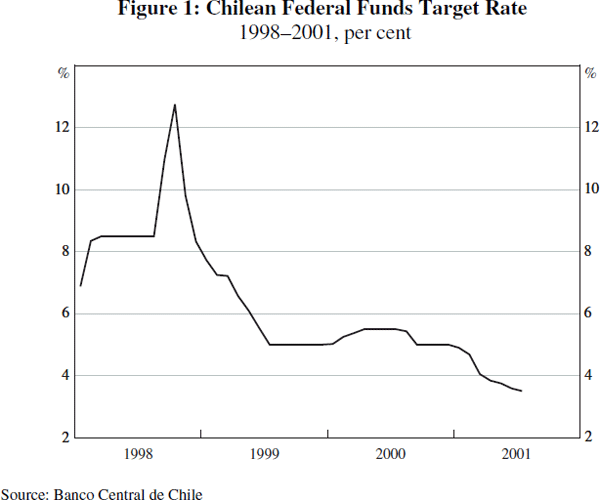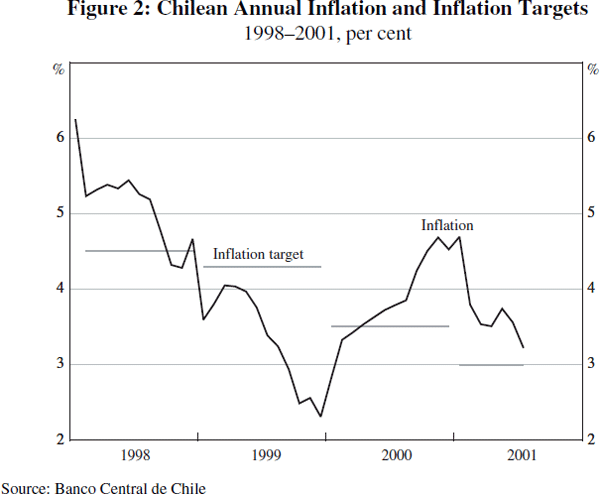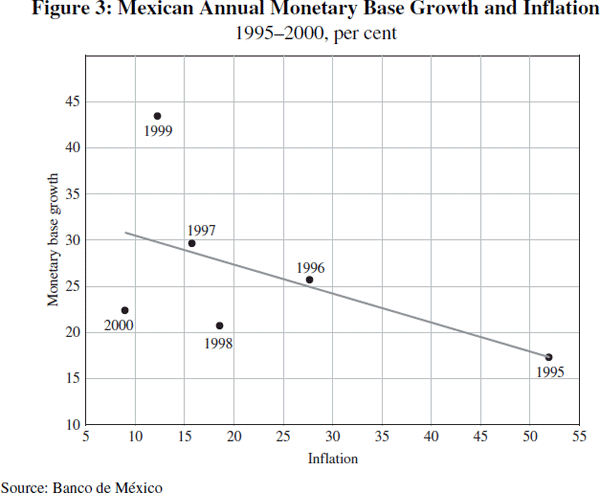RBA Annual Conference – 2001 Discussion
1. Alejandro Werner
Introduction
Guy Debelle's paper makes a strong case for the adoption of an inflation-targeting framework by east Asian countries. This is in stark contrast to the conclusion reached by Masson, Savastano and Sharma (1997), who claim that for most developing countries, inflation targeting is not suitable because central banks lack the ability to conduct an independent monetary policy, their inflation forecasting models are highly uncertain and the inflation objective is subordinated to an exchange rate goal. In the present paper, the author claims that some of these problems apply to any alternative monetary policy framework and others were also present when developed countries first adopted inflation targeting. Therefore, the author concludes that for most east Asian countries inflation targeting is a viable alternative.
Implicit in the paper is the idea that, in a world of floating exchange rates and unstable relationships between monetary aggregates and prices, the only viable option for central banks is forward-looking monetary policy. That is the way monetary policy is conducted by inflation targeters and non-inflation targeters alike. Therefore, the main strength of inflation targeting is that it establishes a transparent framework for the conduct of monetary policy that is useful as a marketing device, a communication tool and a mechanism of accountability to the public at large. This feature is even more valuable when a central bank does not enjoy full credibility.
Following this line of thought, the author highlights three defining features of inflation-targeting regimes: the primacy of the inflation objective, instrument independence, and transparency and accountability. In this respect, it is interesting to draw on the Latin American experience to see how, as some of these features fell into place, some regional central banks have shifted to inflation targeting. The main factors that influenced the transformation of central banks in Latin America were:
- The mounting evidence that shows the costs of inflation in terms of output growth, income distribution and financial sector deepening, and the regional experience with high rates of inflation, that in some cases became hyperinflation. These factors temporarily closed the door to any short-term benefit associated with discretionary monetary policy, and increased the awareness of the high costs and limited benefits of the monetary authority not focusing on price stability.
- After years of fiscal mismanagement, there has been an important strengthening of public finances and a trend towards improving fiscal institutions, eliminating pressures for monetising public sector deficits.
- The balance of payments and financial crises of the 1990s highlighted the difficulties faced by countries that try to fix their exchange rates in a world of highly mobile capital. Since the Mexican crisis of 1994–1995 several countries of the region have abandoned their predetermined exchange rate systems and adopted some form of floating regime.
The first two factors led in the late 1980s and early 1990s to a move towards granting independence to some regional central banks and assigning them with the clear objective of pursuing price stability. The independence gained by the regional central banks gave incentives for further consolidations of public finances, given that it forbade the monetary authority from financing public sector deficits. In most cases, the independence was granted during a period when predetermined exchange rate regimes were in place; therefore, the operational aspects of monetary policy did not change much.
The third point, the adoption of floating regimes, proved to be the other big influence that affected monetary policy in the region. It seems that, given the vulnerability of many Latin American economies to changes in commodities' prices and capital flows, a floating regime is an appropriate currency arrangement.
As exchange rate regimes were made more flexible and central banks gained independence, inflation-targeting regimes were adopted. Chile and Mexico underwent a gradual transition where, for some time, an inflation-targeting framework coincided with a crawling exchange rate band in the first case, and monetary targets in the second. On the other hand, Brazil embraced a fully fledged inflation-targeting framework immediately after the devaluation of the real, as a way to generate sufficient confidence in the new regime to avoid the inflationary effects of the devaluation. Until now, these experiences have been positive for our countries, proving that developing countries have been able to overcome the obstacles mentioned by Masson et al (1997) and consolidate their inflation-targeting frameworks.
In the rest of my comments I would like to complement the arguments made in the paper regarding the independence of the central bank and the role of transparency and accountability in inflation-targeting regimes. In addition, I would like to focus on the role of the exchange rate in the monetary policy framework and the co-existence of inflation targets with exchange rate objectives or monetary targets.
Goal and instrument independence
The paper highlights the fact that goal independence is generally absent in most inflation-targeting countries while instrument independence is useful for the implementation of these regimes. Also, the author states that goal dependence is appropriate in a democratic society and by increasing the government's commitment to the inflation goal, its credibility is enhanced. In addition, the theoretical work from which the recommendations for central bank independence arise stresses instrument independence, not goal independence. The basic argument this literature addresses is how to overcome the time-inconsistency problem faced by the monetary authority when trying to achieve an inflation objective that comes from the social utility function. Therefore, in all these papers, the implicit assumption that is made is that the central bank should be goal-dependent, and that to be able to achieve the public's inflation objective it is useful to grant instrument independence and generate incentives for the monetary authority to make it more inflation averse than society. Therefore, the theoretical literature also points towards goal dependence and instrument independence.
Accountability, communication and the effectiveness of monetary policy
The paper stresses the importance of transparency and accountability to balance the greater independence enjoyed by central banks. However, the paper does not mention another key benefit of increased transparency and accountability, that is to increase the effectiveness of monetary policy.
Establishing a clear set of short-and medium-run objectives, and setting up the channels through which central banks communicate what actions are being undertaken to accomplish these goals, increases the efficiency of monetary policy. This is the case because the effects of monetary policy actions on the whole yield curve, other asset prices and wage-and price-setting behaviour hinge heavily on expectations. Therefore, if the actions undertaken by the monetary authority are clearly interpreted by market participants, their effect on inflation expectations, price-and wage-setting behaviour, long-term interest rates and other asset prices will be closer to the ones desired by the authorities. Second, by providing a structure that allows short-term deviations from the target when negative shocks appear, while maintaining the long-run inflation objective, the long-run target plays the role of a successful nominal anchor. Third, by explicitly talking about the balance of risks in the inflation projection, and in some cases even quantifying it, the monetary authority is able to convey the message that there is a need for constant monitoring, and quick reactions in case a negative shock arises, by clearly specifying what would happen in the absence of a policy response. Fourth, by establishing clear mechanisms of accountability, the inflation-targeting framework provides a useful technology to discipline the monetary authority and support compliance with the targets. Finally, by increasing society's awareness of the benefits of price stability and raising the visibility of the goals of monetary policy, the central bank influences other macroeconomic policies to be consistent with the inflation targets. In sum, an active communication policy and a transparent policy framework enhance the efficiency of monetary policy.
The role of the exchange rate in the monetary policy framework
The greater openness of many emerging markets does open the door for the exchange rate to play a larger role in the transmission mechanism and in the monetary policy framework. However, in my opinion, this should be captured by the macroeconomic model itself in its output gap and price equations and, to a first approximation, does not warrant the inclusion of an extra term in the objective function. In addition, the link between monetary policies and exchange rates might be tenuous in the short term, thus compromising the credibility of the monetary authority. Having said that, I do agree with the author that, under exceptional circumstances, the monetary authority should react to disorderly exchange rate movements when they threaten the stability of financial markets. However, these cases are sufficiently infrequent and hard to describe ex ante in terms of exchange rate movements that they should be treated more as an escape clause than an integral part of the central bank's objective function.
In addition, the paper raises the point made by Eichengreen and Hausmann (1999) who claim that in most emerging markets the magnitude of the stock of foreign-currency-denominated debt biases the monetary authority towards reducing exchange rate flexibility. This should be more a transition issue than a steady state problem for the monetary authorities. This is the case because, in many instances, the dollarisation of liabilities is the product of the previous predetermined exchange rate regimes where, through an implicit exchange rate guarantee, the private sector did not fully internalise the currency risk of their portfolio decisions. The Mexican experience with foreign-currency exposure of the corporate sector is a good example of this argument. If we look at the ratio of foreign-currency-denominated debt to exports of Mexican corporates we observe a significant decline after the adoption of the floating regime (Table 1). This result holds for all types of firms.
| 1992 | 1994 | 1996 | 2000 | |
|---|---|---|---|---|
| All firms | 246 | 389 | 192 | 156 |
| Small firms | 131 | 300 | 132 | 116 |
| Medium firms | 223 | 442 | 209 | 158 |
| Large firms | 385 | 377 | 209 | 199 |
| Firms with USD debt | 279 | 399 | 200 | 156 |
|
Source: Martínez and Werner (2001) |
||||
Inflation, exchange rate and money targets
The paper views the co-existence of an inflation target with an exchange rate band as feasible, as long as a clear lexicographic ordering in favour of the inflation goal is established. Although in principle this argument is correct, in practice there have been cases where the co-existence of the inflation target with other intermediate targets has proven problematic. This has been due either to the lack of public understanding of the lexicographic ordering or to the fact that in some instances, when an exchange rate band is under pressure, it is not the best time to abandon it, and so the lexicographic ordering is reversed. To illustrate this argument, I will draw on the Chilean and Mexican experiences where, for a while, inflation targeting was implemented together with an exchange rate target zone in the first case and a base money commitment in the second.
Chile: During 1998 the Chilean currency was subject to intense pressures as a result of the fall in the terms of trade and contagion from the international financial crisis. Because of this the exchange rate depreciated within the band and the authorities decided to narrow the band. The increases in interest rates needed to defend the exchange rate generated an undershooting of the inflation target. This result and the future adoption of a fully floating exchange rate regime suggest that in that instance, it was not clear whether interest rate policy was able to implement the desired lexicographic ordering (Figures 1 and 2).


Mexico: Since 1995 the central bank has published, at the beginning of the year, a projection of the expected growth of the monetary base in the year to come. Since 1997 the bank has published the expected daily trajectory of the monetary base. Because of this many analysts viewed this trajectory as an intermediate target, generating confusion in the way the private sector interpreted the central bank's reaction function. This confusion was amplified by the fact that during this period the relationship between money growth and inflation was negative due to financial innovation and the remonetisation process the economy went through (Figure 3).

As a result of this, in those years in which the inflation target was met, money growth stood above its projection. On the contrary, when the central bank missed the inflation target, money growth was equal to the projection. Therefore, in this experience, there were many instances when the public focused too much on money growth exceeding the projection while inflationary pressures were receding. As a result of this experience money growth projections have been significantly downplayed in Mexico's monetary policy framework (Table 2).
| Inflation objective | Observed inflation | Targeted monetary base growth | Observed monetary base growth | Inflation expectations at start of year |
|
|---|---|---|---|---|---|
| 1995 | 42.0 | 52.0 | 29.1 | 17.3 | 29.9 |
| 1996 | 20.5 | 27.7 | 28.6 | 25.7 | 28.6 |
| 1997 | 15.0 | 15.7 | 24.5 | 29.6 | 18.2 |
| 1998 | 12.0 | 18.6 | 22.5 | 20.8 | 13.2 |
| 1999 | 13.0 | 12.3 | 18.1 | 43.5 | 16.5 |
| 2000 | 10.0 | 8.9 | 20.6 | 22.4 | 11.1 |
|
Source: Banco de México |
|||||
To conclude, I would like to stress that the recent experience of those Latin American countries that have adopted inflation targeting lends support to the thesis presented in the paper that this is a suitable monetary framework for many emerging markets.
References
Eichengreen B and R Hausmann (1999), ‘Exchange Rates and Financial Fragility’, NBER Working Paper No 7418.
Martínez L and A Werner (2001), ‘The Exchange Rate Regime and the Currency Composition of Corporate Debt: The Mexican Experience’, Banco de México, mimeo.
Masson PR, MA Savastano and S Sharma (1997), ‘The Scope for Inflation Targeting in Developing Countries’, IMF Working Paper No 97/130.
2. General Discussion
While discussion covered a number of topics, the central theme was the nature of inflation targets and how they could be structured. Some participants would have preferred to see more explicit consideration of the difference between flexible targets and hard targets. For example, it may be impossible to establish credibility without first using hard targets; however, these hard targets may be ultimately counterproductive to growth.
Given the option canvassed in both Debelle's and Williamson's papers that inflation targeting and exchange rate management could co-exist, one participant wondered how conflicts between inflation targets and exchange rate targets could be managed. He suggested that a medium-term target on inflation would allow some flexibility to deal with short-term exchange rate fluctuations. Another alternative offered was that an inflation-targeting country might choose to have wider bands on their exchange rate target than otherwise. Yet another participant emphasised that the choice was not strictly between a hard inflation target or a hard exchange rate target but that intermediate regimes were possible in just the same way that BBC regimes were possible for exchange rates. A response offered was that questions of whether to use hard or soft targets are not unique to inflation but affect practically all targeting regimes. As the ultimate objective of the inflation target was to improve welfare this could be used as the arbiter when conflicts between, say, inflation and exchange rate targets emerged.
In further discussion the examples of Chile and Israel were introduced. Chile was given as an example of the problems that can emerge with two targets. One participant suggested that the problem was not that Chile had two targets but that it alternated between governors with different objectives and targets. Another participant responded that central banks may well adopt targets before they publicly announce the change as a way of testing the water. In that case there may be a difference between public announcements of policies and actual actions. In a similar vein to Chile there was some discussion of exactly how Israel operated. While some participants believed that Israel operated both an exchange rate and inflation target, others suggested that Israel used the exchange rate as the instrument to achieve their inflation target. These discussions highlighted the problems of interpretation when looking at the actions of central banks around the world – people frequently had differing understandings of the same actions.
In discussing the objectives of monetary policy one participant suggested that there was a feeling that confining monetary policy just to inflation targeting was too narrow a role for such a powerful instrument. It was felt, in some quarters, that you should be trying to smooth the cycle as well as achieving many other objectives. This view, it was suggested, may well create problems when trying to persuade countries to adopt inflation targets in Asia.
One participant raised the issue of a potential conflict of interest between political ownership of monetary policy targets and independence. Another participant responded that the central bank should not have goal independence but should have flexibility on how to achieve its goal(s).
Finally, a participant suggested that asset price inflation should be included in the inflation measures used in developing countries due to the large influence of asset prices on developing economies. Another participant responded that we may not know enough about asset prices to include them in an appropriate way – the advantages from doing so may not be that large even if they are included. Additionally, it was cautioned that central banks should be modest about what they can achieve and including asset prices in the inflation measure would implicitly suggest that the central bank would try to control asset price inflation as well as consumer price inflation, and that this was not desirable.